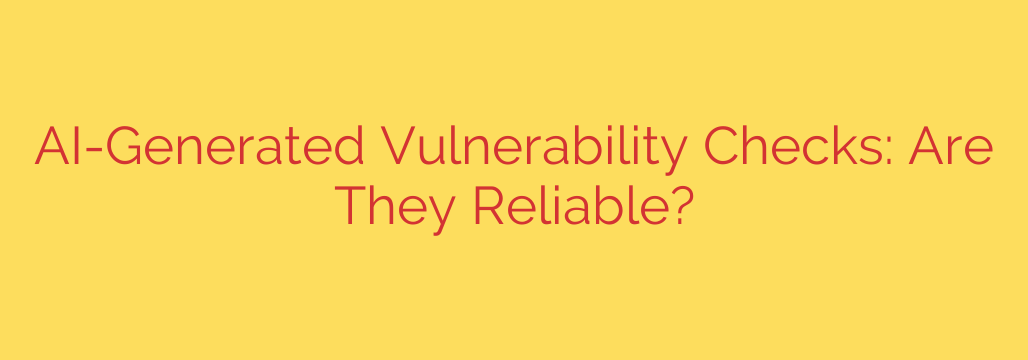
Can You Trust AI to Find Your Security Flaws? A Deep Dive into AI Vulnerability Checks
Artificial intelligence is transforming industries, and cybersecurity is no exception. The promise of using AI and Large Language Models (LLMs) to automatically detect security vulnerabilities in code is incredibly compelling. Imagine a tool that can scan millions of lines of code in minutes, pinpointing weaknesses that could lead to a catastrophic breach. But as this technology rapidly becomes more accessible, a critical question emerges: are AI-generated vulnerability checks truly reliable?
The short answer is nuanced. While AI offers unprecedented speed and scale, it is not a silver bullet for security. Understanding both its powerful capabilities and its significant limitations is essential for any organization looking to strengthen its security posture.
The Power and Promise: How AI is Revolutionizing Security Scans
AI-powered tools bring several game-changing advantages to the table. They operate on a scale that is simply impossible for human teams to match, making them invaluable for modern, complex software environments.
The primary benefits include:
- Unmatched Speed and Scale: AI can analyze vast codebases and complex applications in a fraction of the time it would take a human security analyst. This allows for continuous scanning and a much faster feedback loop for developers.
- Advanced Pattern Recognition: Unlike traditional scanners that rely on predefined rules, AI can identify subtle, complex, and novel patterns of vulnerabilities that might otherwise go unnoticed. It learns from enormous datasets of code, recognizing the tell-tale signs of a potential flaw.
- Reducing Alert Fatigue: Security teams are often overwhelmed by a flood of alerts from various tools. A well-trained AI can help prioritize the most critical threats, filtering out low-risk findings and reducing the noise so human experts can focus on what truly matters.
Proceed with Caution: The Limitations and Risks of AI Scanners
Despite their potential, relying solely on AI for vulnerability detection is a dangerous strategy. The same technology that makes AI powerful also introduces unique and significant risks that must be carefully managed.
Here are the key areas where AI vulnerability checks fall short:
- The Problem of “Hallucinations”: LLMs are designed to generate plausible-sounding text, but they don’t possess true understanding. This can lead to them confidently reporting vulnerabilities that don’t actually exist (false positives). Chasing these phantom flaws wastes valuable time and resources.
- A Critical Lack of Context: AI struggles to understand the business logic and specific context of an application. It might flag a theoretical weakness that has no real-world impact due to other security controls, or it may miss a critical flaw because it doesn’t understand how different components of a system interact. Risk assessment requires contextual awareness that AI currently lacks.
- The Danger of False Negatives: Even more dangerous than a false positive is a false negative—when the AI fails to detect a real, exploitable vulnerability. Over-reliance on AI can create a false sense of security, leaving critical backdoors open to attackers while the team believes the code is secure.
- Training Data Bias: An AI is only as good as the data it was trained on. If its training dataset lacks examples of newer or more obscure types of vulnerabilities, it will be blind to them in its analysis.
Best Practices for Integrating AI Vulnerability Checks Safely
AI is not a replacement for human expertise; it is a powerful force multiplier. The most effective security strategy uses AI as a tool to augment the skills of security professionals, not to supplant them. By adopting a “human-in-the-loop” approach, you can leverage the speed of AI while mitigating its risks.
Here are actionable steps for safely integrating AI into your vulnerability management program:
- Treat AI Scans as a First Pass: Use AI-generated reports as a starting point for your investigation, not as the final verdict. Its primary role should be to quickly identify potential areas of concern for deeper analysis.
- Always Verify AI Findings: Never trust an AI-generated vulnerability report without independent verification. A human security expert must always review, validate, and test any critical vulnerability flagged by an AI tool before dedicating resources to a fix.
- Combine AI with Traditional Tools: Don’t discard your existing security tools. A robust security program should use a layered approach, combining AI scanners with traditional Static Application Security Testing (SAST) and Dynamic Application Security Testing (DAST) tools for comprehensive coverage.
- Prioritize Based on Business Impact: Use human intelligence to prioritize vulnerabilities. A human analyst can assess the real-world risk of a flagged weakness based on its location in the application, the data it protects, and the overall business context.
- Invest in Continuous Training: Ensure your security team is trained not only on cybersecurity principles but also on the specific limitations and behaviors of the AI tools you employ.
The Verdict: A Powerful Tool, Not a Panacea
So, can you trust AI to find your security flaws? The answer is yes—but only with strict human oversight. AI-powered vulnerability checks are a revolutionary development in cybersecurity, offering capabilities that can dramatically improve efficiency and detection rates.
However, their inherent weaknesses, such as a lack of context and the potential for both false positives and negatives, make them unreliable as a standalone solution. The future of elite cybersecurity isn’t fully automated—it’s a symbiotic partnership between machine-speed analysis and expert human judgment. By embracing AI as a sophisticated assistant rather than an infallible authority, organizations can build a more resilient and secure digital future.
Source: https://www.bleepingcomputer.com/news/security/can-we-trust-ai-to-write-vulnerability-checks-heres-what-we-found/








